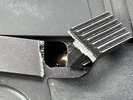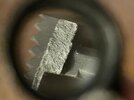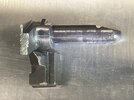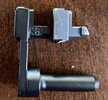If going for strength then forged is high up the list. Milled from bar stock is best (billet by common nomenclature).
The big things are grain structure, porosity, and stress. Bar stock or billet material is made in such manner to have the most uniformly good quality of whatever metal it is. Very very little if any porosity or internal stress. Generally the most best and most uniform grain structure, unless heat treated or quenched when formed but even still great material.
Forged… hot forge… bar stock is heated to near melting point, and formed by force whether that be squeezing in a press, hit by hammer, upset into a mold, etc. Cold forge… primarily things like barrels. It’s worked by striking and compressing in a controlled manner. Hot forging leaves a little stress. Cold forging leaves more stress but cold forging is generally not doing major shaping changes. Still very little if any porosity, grain structure relatively unchanged.
Cast… molten material poured or injected into a mold and allowed to cool. Under perfect scenario extra material is used to push air out of the mold and the mold is made in such manner to help air escape. There is porosity in cast metals. Period. Different metals get porosity at varying degrees but there will be tiny air bubbles in the metal. Possibly inclusions of other materials from the mold or process. The casting will then have to cool off, and hopefully will cool uniformly and slowly or it can impart stresses from contracting at different rates. Complex shapes like pistol frames or AR lowers can be cooled slowly to avoid cracking but if quenched there’s a good chance that they are cracking. Grain structure depends upon conditions of the casting.
Stamped takes flat stock, usually some form of bar stock that has been mechanically flattened to a given thickness. Stamping dies both form and cut material under high pressure. This can leave a lot of stress in the parts, but since it’s essentially just re-formed bar stock it’s pretty good. Stamping has limitations though and for guns the shapes are generally too intricate or require thickness and shapes that just don’t make sense for stamping unless it will be multiple parts welded together in which case you often have slightly different material in welding material, porosity in the weld, stresses in the metal as the metals heat and cool quickly. This can be done quite well, but the guns either look and feel cheap, or they need a good bit of work after this process to look like much. Think liberator pistol, ww2 grease gun.
So depending upon what the part is or what attributes it needs… any of the types of material forming can work. It’s just a factor of picking the process that leaves the best qualities to meet criteria. Strong and pretty- probably billet that’s machined. Strong and looks don’t matter, stamped. Built quick to win a war, stamped and welded is a proven winner.





